Getaway Driving Techniques for Escape and Evasion -Ronald George Eriksen-II-Loompanics-Unlimited
DISCLAIMER
I WILL NOT BE HELD RESPONSIBLE FOR ANY DAMAGE TO PROPERTY OR LIFE AND/OR PERSON IF ANY ARISES FROM READING THIS ARTICLE. I ASSUME THAT THE READER IS OF LEGAL AGE AND RESPONSIBLE ENOUGH TO TAKE RESPONSIBILITY FOR HIS OWN ACTIONS.
THIS ARTICLE IS FOR EDUCATIONAL PURPOSES ONLY AND SHOULD ONLY BE ATTEMPTED BY PROFESSIONALS IN A LEGAL MANNER. THIS BOOK IS FREELY DOWN-LOADABLE FROM THE INTERNET IF YOU HAVE THE PATIENCE TO SEARCH FOR IT AND DOES NOT INFRINGE ON ANY RIGHTS WHATSOEVER. ALL COPYRIGHT CREDITS GOES TO THE AUTHOR MENTIONED IN THIS BOOK.
FAST AND THE FURIOUS :-)
As my first post I thought I might begin with this short PDF document that can be freely downloaded from the internet
if you have the patience to search for it. Again I am not claiming any copyright or ownership of the content all we're
trying to do here is share this information for all to copy and download at their leisure. In time I will be posting more
articles similar to this one and might touch on survival skills more, as I've been inspired by reading another article here
recently regarding zombie apocalypse and said to myself why not, I have tons of documents sitting in my documents directory
and I've been wanting to find a way on how to share it with everyone. Here it is below unedited from the book of the author
on the title bar. If you enjoyed reading this why not give it an upvote and follow/subscribe to get the latest articles. Enjoy

GETAWAY
Driving Techniques for Escape and Evasion
By Ronald George Eriksen 2
Loompanics Unlimited
Port Townsend, WA
GETAWAY: Driving Techniques for Escape and Evasion
© 1983 by Ronald George Eriksen 2
All Rights Reserved
Printed in USA
Published by:
Loompanics Unlimited
PO Box 1197
Port Townsend, WA 98368
Cover and illustrations by Kevin Martin
“Make preparation in advance. You never have trouble if you are prepared for it.”
- Theodore Roosevelt, 1910
“Know the enemy and know yourself, in a hundred battles you will never be in peril.” - Sun Tzu, 400 B.C.
About the Author
Ronald George Eriksen 2 is a veteran dirt track racer and survivor of several demolition derbies.
In 1981 he graduated from the Bob Bondurant School of high performance driving in Sonoma,
California. Other books by Eriksen include HOW TO FIND MISSING PERSONS and HOW TO GET
I.D. IN CANADA .
PREFACE
Many people have become concerned with the dramatic rise in assassinations and
kidnappings in recent years. A great number of these attacks have occurred while the victim
was in his automobile. The purpose of this book is to instruct the reader in the proper handling
of his vehicle in the event of such an attack.
The skills of a grand prix driver are not necessary to learn these maneuvers. A few days
of practice is all that is required. The time spent practicing is trivial when you consider what
might happen if you are not prepared.
CONTENTS
Vehicle Recommendations ................................................... 1
Vehicle Improvements......................................................... 2
Vehicle Security................................................................... 7
Surveillance and Anti-Surveillance ........................................ 9
Cornering ............................................................................ 14
Bootlegger's Turn ............................................................... 19
Moonshiner Turn (Reverse 180) ......................................... 22
Ramming............................................................................. 24
Vehicle Attack...................................................................... 31
Chase Situations ................................................................. 35
Suggested Training Schedule ............................................. 38
Conclusion .......................................................................... 39
Useful References................................................................ 40
VEHICLE RECOMMENDATIONS
The maneuvers in this book can be done in just about any car. The only cars which are
completely unsuitable are jeep-type vehicles. Although fine for going off the road, jeeps have a
tendency to tip over during turns.
The ideal vehicle is one that is powerful, easy to handle, and above all else, reliable. I
have found that German-made cars are among the best in these respects. The only recently
made German car that is under par is the Volkswagen "Rabbit" which is just too small and
underpowered.
Although there are some notable exceptions, American and Japanese cars are not well
known for their handling and performance qualities. They are made to give a soft cushy ride
and little else. If you have to buy one of these, try to avoid both the small economy types and
the oversized rolling boats, such as the larger Buicks and Oldsmobiles.
Also to be avoided are exotic European cars such as Ferraris and Lotuses. Although they
are a true pleasure to drive, the fact that they stand out so much makes them a prime target
for an attack.
VEHICLE IMPROVEMENTS
Listed below are modifications which will enhance both the performance and reliability of
a vehicle. Also listed are modifications which will serve as deterrents to an attack.
Tires
Get the best radial tires you can afford. Radials offer increased durability, superior
handling, and better gas mileage than old-fashioned bias ply tires. Also, to some degree, radials
are bullet resistant. Be sure to slightly over inflate all four tires and to fill them with run flat
foam (available in auto supply and department stores).
Heavy Duty Radiator
Hard driving, hot weather and rough terrain make for overheated engines. A heavy duty
radiator helps prevent this from happening.
Heavy Duty Shocks and Springs
Other than good tires, nothing will improve your car's handling more than top quality
shocks and springs. Shocks and springs are items where price is an indication of quality, so get
the best you can afford.
Stainless Steel Brake Lines
Rubber brake lines sometimes swell and flex, causing the brakes to fade. Stainless steel
brake lines are used in racing competition and are recommended particularly to those living in
mountainous areas.
Heavy Duty Steering Pump
If your car has power steering, a series of quick turns might cause the steering fluid to
foam, making steering extremely difficult. A heavy duty steering pump serves to prevent this.
Heavy Duty Battery
If you are going to add additional lights and communications gear to your car, a heavy
duty battery is a must.
Lights
You should replace your old-fashioned sealed beam headlights with quartz-iodine lights.
These give off twice the light of the sealed beam units and will enable you to drive much faster
at night. There are quartz-iodine lights to fit almost every vehicle. You might also consider
mounting additional lights on your vehicle. Auxiliary lights should be mounted low and angled
slightly outward.
Spotlights
Four high intensity spotlights should be mounted high on your vehicle. These will
effectively blind an attacker. Three of the spotlights should be directed to the front, one aiming
straight ahead and the other two angled slightly outboard. A fourth light should be aimed to the
rear.
Cut Out Switches
Cut out switches enable you to independently control each light on your vehicle. The
addition or elimination of various lights at night will alter the appearance of your vehicle and
might allow you to lose a pursuer.
Vehicle Alarm System
A good alarm system should not only guard against theft, but also against tampering.
"Consumer" type publications often rate the various alarm systems and you should consider
their advice before buying one.
Armor
There are many problems involved in the armoring of vehicles, not the least of which is
cost. A bargain basement armoring job, offering some protection against a .30 caliber rifle will
cost you about $20,000. A fully armored vehicle capable of withstanding repeated hits from a
.30 caliber rifle will run you about $200,000. Most of us don't have that kind of money lying
around.
Another problem with armoring is that there is no such thing as bullet proof glass. There
is only "bullet resistant" glass. We saw how effective this glass was during the attempted
assassination of President Reagan. During the attack, a round from the assailant's lowly .22
pistol penetrated the glass on the presidential vehicle.
Yet another problem associated with armoring is the weight added to the vehicle. A
25% increase in vehicle weight will cause a corresponding decrease in the vehicle's handling
capabilities.
If you can't afford the high cost of a full armor job, then I suggest that you affix a half-
inch aluminum plate to the back of each seat. For most of the evasive maneuvers in this book,
the only clear shot a bandit or terrorist will have is at the rear of your vehicle. While the half-
inch plate won't protect you against all weapons, it does offer inexpensive protection against
submachine guns and pistols.
C.B. Radio's
Even though C.B. radios are a virtual party line, the fact that somebody is always
listening in could prove useful in an emergency. Also to be considered is the use of two-way
radios between the car and home.
Siren and Oscillating Light
A siren and oscillating light will attract attention in the event of an attack. Don't use
them except in an emergency, as law enforcement people tend to frown on civilian use of them.
Good Mirrors
Either wide angled or electronically controlled mirrors will allow you to see what is going
on behind you without turning your head.
Locking Gas Cap
A locking gas cap prevents anyone from using the gas tank as a receptacle for
explosives. It will also prevent Halloween pranksters from putting unwanted items in the tank.
Gun and Crowbar in Trunk
Kidnappers have been known to throw the victim into the trunk of his own car. A gun
and a prying instrument such as a crowbar could prove useful in an escape.
Pressurized Oil Slick
A pressurized device which sprays oil onto the roadway will eliminate almost any
pursuer. A book which details how to make one of these devices is mentioned in the reference
section.
Caltrops
Caltrops are metal spikes constructed so that one point is always up. If thrown in the
road behind you, they will flatten the tires of a pursuing vehicle. One company who sells them
is Beaver Products, PO Box 1580, Anna Maria, FL 33501.
Thick Bolt Through Tailpipe
A thick heavy bolt put through the tailpipe and welded into place will prevent a bomb
from being placed in the exhaust system.
Smoke Screen
A cheap but effective smoke screen can be made as follows: First drill a hole into the
exhaust manifold of your car, and weld the nozzle of a small plant sprayer over it. A gas line is
then run from the nozzle to a pump and container containing castor oil inside the vehicle.
Clouds of smoke are produced by pumping the castor oil onto the hot exhaust manifold.
In a recent Chicago bank robbery, the bandits fabricated a smoke screen by filling a fire
extinguisher with some chemical. What the chemical was and how they shot it out of the
vehicle, I don't know. I do know that in addition to the considerable smoke, a noxious odor was
also produced.
Reinforced Ram Bumpers
Bumpers can be reinforced by bolting or welding extra supports from the vehicle frame
to the bumper. Further reinforcement can be made by welding a two-inch metal pipe to the
vehicle frame, right in back of the bumper. These extra reinforcements could prove useful in a
ramming situation.
Survival and First Aid Kit
A good emergency survival kit, including an extra jack, and a first aid kit should be in
every vehicle.
KEY
1 Tires
2 Heavy duty radiator
3 Heavy duty shocks
4 Stainless brake lines
5 H.D. steering pump
6 H.D. battery
7 Lights
8 Spotlights
9 Cutout switches
10 Alarm
11 Armor
12 CB radio
13 Siren & light
14 Mirrors
15 Locking gas cap
16 Escape kit
17 Oil slick
18 Bolt thru exhaust
19 Smokescreen
20 Gun ports
21 Ram bumpers
Illustration of a car with all vehicle recommendations.



VEHICLE SECURITY
Both terrorists and everyday street criminals operate in a fashion similar to predatory
animals -- they will always choose the weakest prey or the easiest mark to attack. By being
security conscious at all times, you can increase the odds that they will choose someone else.
What follows are some general security recommendations which can be easily
implemented when in or around your vehicle. These recommendations will be your first line of
defense against an attack.
(1) Vary the times and routes to and from work. Avoid fixed routines.
(2) Have thorough knowledge of the area you are driving in.
(3) Avoid getting boxed-in in traffic.
(4) Always park so you have a fast exit from your parking space.
(5) Never stop for anyone.
(6) Drive on major thoroughfares, if possible.
(7) Know the shortest routes to police stations, hospitals, army outposts, etc.
(8) Check rear-view mirrors frequently.
(9) Inform someone of your destination and estimated time of arrival.
(10) Be wary of groups of men in uniform (jogging suits, janitor outfits, etc.).
(11) Never trust anyone with your key.
(12) Avoid construction areas.
(13) Keep your gas tank at least half full.
(14) Never depend on a chauffeur. Drive yourself.
(15) If your car has been left alone, check it thoroughly for tampering before driving it.
(16) If suspicious people are observed loitering about your vehicle, avoid it.
(17) Maintain a low profile.
Obviously, not everyone need be so concerned with their personal safety. The security
needs of someone living in Medicine Hat, Wyoming, will be considerably different from someone
living in El Salvador. You alone will have to determine what your particular situation requires.
Color Code
One excellent way to become alert to danger is through the color code system of
awareness developed by the 82nd Airborne Division in World War II. Here's how it works:
Condition Green . In Condition Green, you are completely relaxed and unalert. If you are
violently attacked while in this condition, you will most likely be destroyed. In today's violent
times one should never be in this condition.
Condition Yellow . This is a state of general awareness. There is no specific threat, but you are
alert and ready for action should any signs of danger occur.
Condition Orange . Here you recognize something specific as a potential threat and your mind is
focused on the danger.
Condition Red . The trouble has escalated and a violent confrontation is unavoidable. You must
act forcefully now.
The most important transition in this color code system is from yellow to orange.
Condition Yellow is simply a state of general alertness. In Condition Orange, there is a specific
possible danger. The sooner you perceive a potentially dangerous situation, the better off you
will be should things degenerate into a violent confrontation.
SURVEILLANCE AND ANTISURVEILLANCE
One of the keys to avoiding a terrorist attack is recognizing when you are under
surveillance. In almost all recent terrorist attacks, the victim had been under surveillance --
sometimes for as long as several months prior to the attack.
In order to stop an attack before it occurs, you must develop surveillance awareness. To
develop this awareness you must be constantly alert to suspicious people in the vicinity of your
home and at work.
In stalking their victims, terrorists have posed as laborers, hookers, derelicts, and used
numerous other ruses. I do not expect you to become a raving paranoid constantly on red alert
against everyone and everything, but it should be in the back of your mind that someone's eyes
might be watching you.
Tactics of Professional Surveillance
To my knowledge, there have been no instances of terrorists using the sophisticated
techniques of surveillance employed by professional investigators. Nevertheless, it can be
assumed that sooner or later they will be using these methods. In any case, it is always best to
be prepared for anything.
The Single Tail
The easiest type of surveillance to detect is when you are being followed by a single
surveillant. The lone surveillant must stay close enough to keep you in sight, yet far enough
away to avoid detection -- no easy feat. In residential areas, he can remain a few cars back due
to the density of traffic. Also he has the option of following the victim on a parallel street. In
rural areas, about all he can do is remaining well back and hope for the best.
The single tail may employ certain tricks of the trade to make his job easier. At night, he
may break a taillight or place a small luminous sticker on the rear of the victim's vehicle to
make it more distinguishable. To decrease the possibility of detection, he may change his
seating position or use various types of disguise.
Professional investigators, whether governmental or private, rarely conduct a
surveillance using a single unit. The risk of getting burned is just too great.SURVEILLANCE AND ANTISURVEILLANCE
One of the keys to avoiding a terrorist attack is recognizing when you are under
surveillance. In almost all recent terrorist attacks, the victim had been under surveillance --
sometimes for as long as several months prior to the attack.
In order to stop an attack before it occurs, you must develop surveillance awareness. To
develop this awareness you must be constantly alert to suspicious people in the vicinity of your
home and at work.
In stalking their victims, terrorists have posed as laborers, hookers, derelicts, and used
numerous other ruses. I do not expect you to become a raving paranoid constantly on red alert
against everyone and everything, but it should be in the back of your mind that someone's eyes
might be watching you.
Tactics of Professional Surveillance
To my knowledge, there have been no instances of terrorists using the sophisticated
techniques of surveillance employed by professional investigators. Nevertheless, it can be
assumed that sooner or later they will be using these methods. In any case, it is always best to
be prepared for anything.
The Single Tail
The easiest type of surveillance to detect is when you are being followed by a single
surveillant. The lone surveillant must stay close enough to keep you in sight, yet far enough
away to avoid detection -- no easy feat. In residential areas, he can remain a few cars back due
to the density of traffic. Also he has the option of following the victim on a parallel street. In
rural areas, about all he can do is remaining well back and hope for the best.
The single tail may employ certain tricks of the trade to make his job easier. At night, he
may break a taillight or place a small luminous sticker on the rear of the victim's vehicle to
make it more distinguishable. To decrease the possibility of detection, he may change his
seating position or use various types of disguise.
Professional investigators, whether governmental or private, rarely conduct a
surveillance using a single unit. The risk of getting burned is just too great.
Parallel Surveillance
This type of surveillance is conducted by two or more vehicles. One vehicle tails the
victim at a reasonable distance. His comrades follow on parallel streets ready to take up close
surveillance should the victim turn (see Figure 1). Obviously, this method will not work in areas
where there are no parallel roads.
Leap Frog Surveillance
In this method, one surveillant tails the victim closely while his partner stays well ahead
of both vehicles (see Figure 2).
The great advantage to this method is that the tailing vehicle can fall far behind while
the lead vehicle slows down and establishes visual contact with the victim. Also, the tailing and
lead vehicles can exchange positions to avoid detection.
The tailing and lead vehicles must be in radio contact for this method to be effective.
Bumper Beepers
The most effective means of tailing a vehicle is with a bumper beeper. An electronic
tailing device, the bumper beeper attaches to the underside of the victim's car. The device
sends beeping signals to a receiver in the tailing vehicle. The closer the tailing vehicle gets to
the target vehicle, the louder the beeps become. The more sophisticated beepers are equipped
with a null switch, whereby a different tone in the beep is produced if the victim turns right or
left. Bumper beepers have an effective range of from 1 to 5 miles. They are usually attached to
the vehicle with powerful magnets, although heavy metal clamps are sometimes used. Beepers
can be either battery powered or attached directly to the target vehicle's own electrical system.
Detection of Bumper Beepers
To determine if you are a victim of these dreaded devices, first make a complete visual
inspection of the underside of your vehicle. What you are looking for is a small metal box with
one or two skinny antennas sticking out of it.
If your search turns up nothing, go out and buy a field strength meter (available from
any electronics store). These devices detect all radio transmissions.
Figure 1
Parallel Surveillance in action
After victim (V) turns, S3 turns after him. S1 and S2 follow on parallel streets.

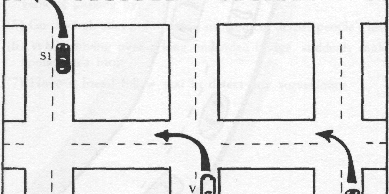
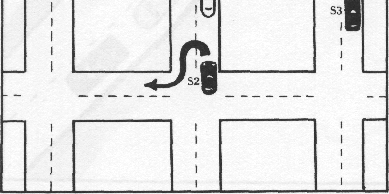
Figure 2
Leap Frog Surveillance
Victim is in white car; surveillants in black cars.
Surveillance vehicles can switch positions to avoid detection.
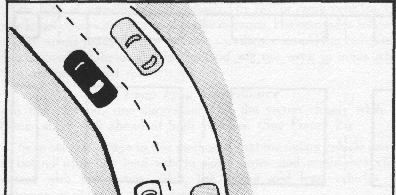
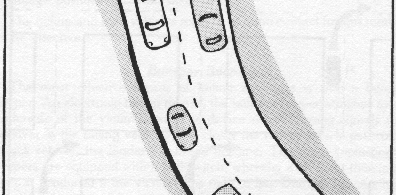
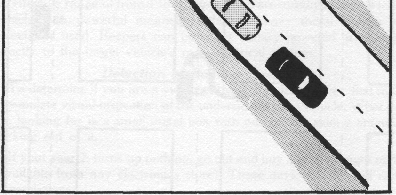
With field strength meter in hand and the vehicle's ignition on, check in, on, and
especially under, your car. If you are a victim of a bumper beeper, the meter will tell you where
it is.
Eluding a Tail
The following will give you some general ideas on how to detect and elude vehicle
surveillance.
(1) After running a red light or driving the wrong way on a one-way street, watch to see
if anyone follows.
(2) While traveling on a freeway at high speed, suddenly cut across four lanes of traffic
and make an exit.
(3) After rounding a blind curve, make a bootlegger's turn and take off in the opposite
direction.
(4) After turning a corner, pull over and park. Take note of all vehicles passing by.
(5) Go through alleys, dirt roads, or even cut across people's lawns.
(6) While driving over a long undivided bridge, suddenly make a bootlegger's turn.
(7) Have a friend follow you to detect any surveillance.
CORNERING
It is a commonly held belief that the best way to handle corners is to blast through them
as quickly as possible. This is completely wrong. The speed at which you exit a corner is much
more important than the speed at which you take the corner itself. Assuming identical cars, the
car which exits the corner at the greater speed will be going faster on any straight stretch of
road that follows.
Proper Apex
The apex of any turn is that point at which your wheels are closest to the inside edge of
the corner. By choosing a relatively late apex, the driver can exit a corner at a greater speed
than if he had chosen an early one.
The 90-degree Turn
Figure 3 shows how to handle a 90-degree turn. This is the most common type of turn,
particularly in urban areas.
This turn is begun as far to the outside as possible. Obviously, if there is a lot of traffic
on the road, you are going to have to adjust your turn. In that case, drive as far to the outside
as you can within the confines of your lane.
Approaching the corner, gradually increase braking pressure to heavy breaking. Be
careful not to lock the brakes, as all this does is prevent you from steering. If you feel any of
the wheels locking up, let off the brakes for an instant, and then reapply them.
After downshifting (manual transmissions only), start trailing off the brakes into the first
third of the turn. Then gradually increase the throttle to full acceleration coming out of the turn.
S Turns
Figure 4 illustrates an S type turn. Actually, this need not be a turn at all, as you can go
straight through it. Remember to set yourself up to take full advantage of any straight that
might follow.
Constant Radius Turn
Figure 5 shows how to handle a constant radius, or "hairpin" turn. The illustration is
pretty much self-explanatory. Don't go too fast on these turns, as you can easily end up off the
road.
Figure 3
Taking a 90-degree turn
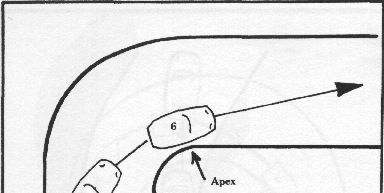
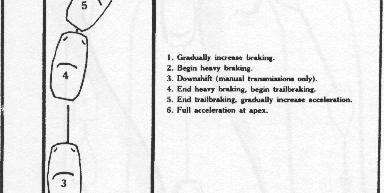
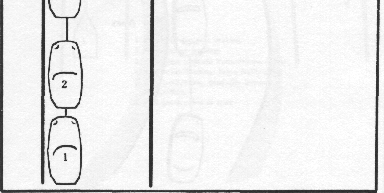
Figure 4
S Turn
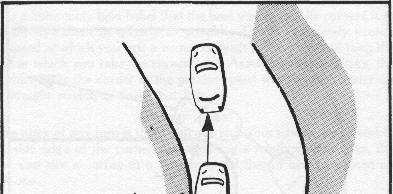
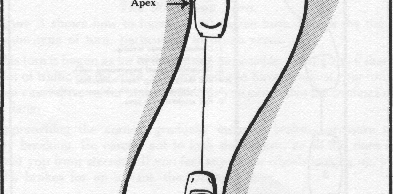
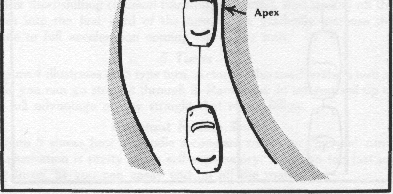
Figure 5
Constant Radius Turn
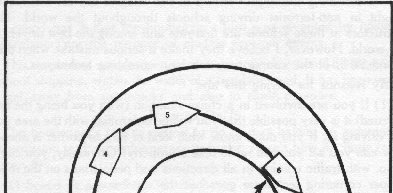
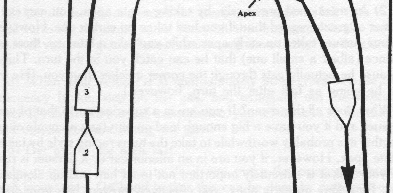
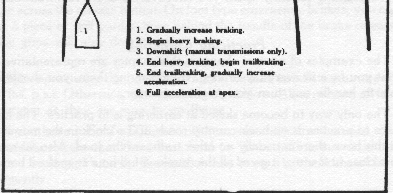
Cornering
The cornering techniques shown in this chapter are the techniques taught in anti-
terrorist driving schools throughout the world. The instructors at these schools are first-rate and
among the best drivers in the world. However, I believe they make a serious mistake when they
spend 70% of the course time teaching cornering techniques.
My reasons for saying this are:
(1)If you are involved in a chase situation (with you being the one pursued) it is very
possible that you will be unfamiliar with the area you are driving in. If you don't
know what kind of turn or corner is ahead, how can you set yourself up to take it
properly? Obviously, you can't. Also, with traffic coming in all directions and
pedestrians on the road, proper cornering technique goes out the window.
As mentioned previously, by taking a late apex, you can exit a corner at greater
speed than if you had taken an earlier one. However, if your pursuer takes an early
apex while you take a late one, there is a chance (albeit a small one) that he can
catch you in the turn. This is because he actually gets through the corner quicker
than you. (He will not be going as fast after the turn, however.) What does all this
mean? If you are in a superior car to that of your pursuer and if you have a big
enough lead on him (say a couple of car lengths) it is probably worthwhile to take
the turns racing style by taking a late apex. However, if you are in an inferior car or
a pursuer is right on your tail, it is extremely important not to let him pull up
alongside you. By taking an early apex, you effectively prevent him from doing so.
Practicing Cornering
(2) The examples of corners shown in this chapter are representative of what you face in
everyday driving. By mastering them, you should be able to handle any turn you might
encounter.
The only way to become skilled at cornering is to practice. The best place to practice is
on back country roads at 3 o'clock in the morning. At this hour, there is usually no other traffic
on the road. Also, as most bars close at 2 a.m., it gives all the drunks a full hour to make it
home.
BOOTLEGGER'S TURN
Legend has it that the bootlegger's turn was invented by hillbilly moonshiners for the
purpose of eluding revenue agents.
This maneuver enables you to change your direction 180 degrees, without stopping,
within the width of a two lane road. It has been used to get away from roadblocks and also to
elude pursuers.
How to Do It
The bootlegger's turn is easiest to do in cars having an automatic transmission and a
hand emergency brake. Here's how it's done (see Figure 6):
(1) Speed at around 25-30 mph.
(2) Get off the gas and crank the steering wheel to the left 1⁄4 to 1⁄2 of a full turn. At the
exact same time, hit the emergency brake hard. Those of you with manual
transmissions will have to depress the clutch, also.
(3) When your vehicle is at approximately 90 degrees, release the emergency brake,
step on the gas, and straighten out the steering wheel.
(4) If you have a manual
transmission, you will have to let the clutch back out as you are hitting the gas.
Get out of the area fast.
This maneuver is easier to do if you make the emergency brake catch inoperative. On hand
brakes this can be done by putting strong tape across the release button. On foot type
emergency brakes, you can put a piece of stiff garden hose behind the handle of the brake
release. Vice grips will also do the job.
Precautions
Before practicing the bootlegger's turn, be sure to inflate your tires to 40 lbs psi.
Otherwise, the sidewalls might blow. Also, remove all four hubcaps, as they are sure to go
flying.
If you have a Ford or Chrysler with an automatic transmission, you should be aware that
these cars tend to "puke out" transmission oil during bootlegger's turns. Because of this, be
sure to check the oil level frequently.
Figure 6
Bootlegger's Turn

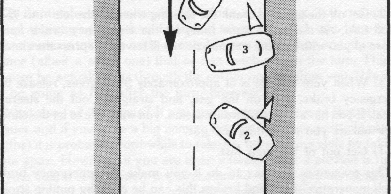
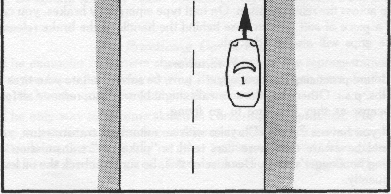
The bootlegger's turn will cause incredible wear and tear on your front tires. For this
reason, it is recommended that you learn how to do the maneuver on rental cars. Hertz, Avis,
Budget, etc., offer a wide variety of cars. You should be able to find something similar to what
you now drive. Needless to say, don't tell the rental agency people what you are planning to
use their car for.
TV Shows
TV programs such as The Dukes of Hazzard, The Rockford Files and The Fall Guy often
show the bootlegger's turn during their chase scenes. The driving in these shows is done by
professionals and you can learn a lot just by watching them. You can also learn a lot from
watching auto races and demolition derbies, both live and on TV.
MOONSHINER'S TURN (Reverse 180)
The moonshiner's turn is another slick maneuver pioneered by the mountain people of
the Southern United States.
Looking like a bootlegger turn in reverse, the moonshiner's turn allows you to change
your direction 180 degrees within the confines of a two lane road, while going backwards.
The proper procedure for this maneuver is as follows (see Figure 7):
(1) Accelerate in reverse to 20-30 mph.
(2) Get off the gas and crank the steering wheel all the way to the left as fast as you
can.
(3) When the car is at 90 degrees, shift into low gear, hit the gas, and straighten out
the steering wheel.
(4) Get out of the area fast.
This maneuver is particularly effective against roadblocks at night. Often the attackers
manning the roadblock will use high-intensity lights to blind the victim as he approaches. By
using the moonshiner's turn, the victim's vision is directed away from the lights.
Figure 7
Moonshiner's Turn

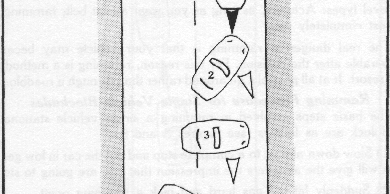

RAMMING
The most common type of vehicle ambush is the stationary roadblock. In this type of
attack, one or two vehicles are lined up across the road blocking the victim's way. The attackers
will usually be standing alongside the blockade vehicles with automatic weapons. When the
unwary and untrained victim sees the roadblock, he will stop, whereupon the attackers will rush
the vehicle and drag him away.
Faced with the above situation, you might not have time to do an evasive maneuver
such as the bootlegger's turn. Your only option may be to ram through the blockade vehicle(s).
To those of you who have experienced it only through television shows, ramming may seem
like a suicidal stunt reserved for Evel Knievel types. Actually, as long as you wear a seat belt,
ramming is almost completely safe.
The real danger in ramming is that your vehicle may become inoperable after the
collision. For this reason, ramming is a method of last resort. If at all possible, go around rather
than through a roadblock.
Ramming Procedure for Single Vehicle Blockades
The basic steps involved in ramming a single vehicle stationary roadblock are as follows
(see Figures 8 and 9):
(1) Slow down almost to a complete stop and put the car in low gear. This will give the
attackers the impression that you are going to stop.
(2) Suddenly hit the gas hard and pick a ramming point.
(3) Hit the target at an angle and keep the accelerator fully depressed through the
collision. Your speed at impact should be between 15 and 30 mph.
(4) After breaking through, get out of the area fast. Even if your car is badly damaged,
keep going.
The ramming points on the blockade vehicle listed in order of preference are: (1) the
rear wheel and rear fender area; and (2) the front wheel and front fender area (see Figure 10).
If either end of the blocking vehicle is up against a curb or wall, you will have to ram through
the other end.
Figure 8
Ramming a Single Vehicle Blockade
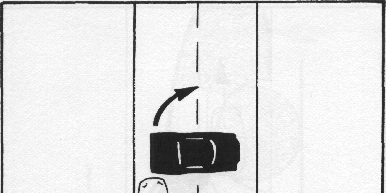
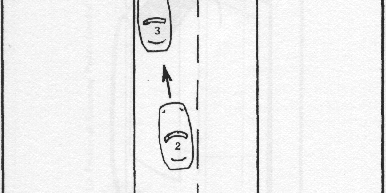
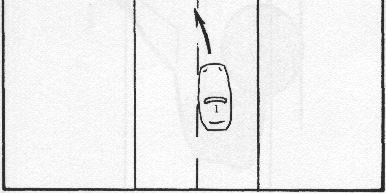
Figure 9
Ramming a Single Vehicle Blockade (cont'd)
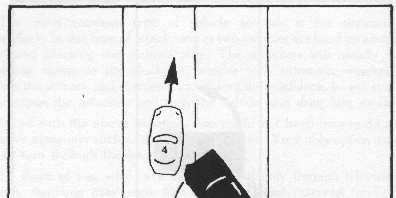
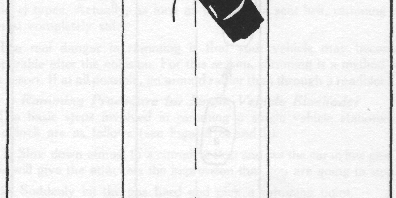

Figure 10
Preferred Ramming Points (shaded areas)


Ramming Procedure: Double Vehicle Blockade
The basic steps involved in ramming through a double vehicle stationary roadblock are
as follows (see Figures 11 and 12):
(1) Slow down almost to a complete stop and put the car in low gear.
(2) Suddenly hit the gas hard and head for your ramming point.
(3) Hit the blockade right in the middle and keep the accelerator fully depressed through
the collision. Your speed at impact should be between 15 and 30 mph.
(4) After breaking through, get out of the area fast.
If any of the attackers should be so foolish as to get in your way, run them over.
Remember, your life is on the line.
Where and How to Practice Ramming
To practice ramming, go to your local auto junkyard and buy three running wrecks.
Move all three to an unused parking lot or abandoned airfield and practice per the directions in
this chapter. For safety's sake, wear a helmet and a seat belt. You might also want to remove
all the glass from the vehicles. Make arrangements to have the cars towed away when you are
done, as you are going to have three non-running wrecks on your hands. Property owners tend
to have bad feelings towards those who litter their land with junk vehicles.
Figure 11
Ramming a Double Vehicle Blockade
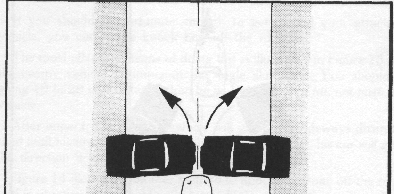
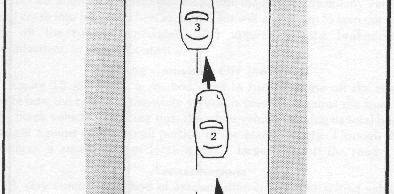
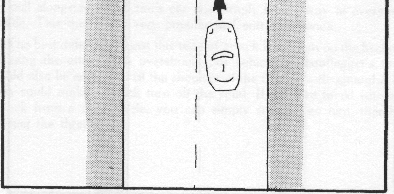
Figure 12
Ramming a Double Vehicle Blockade (cont'd)

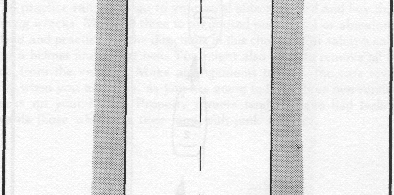
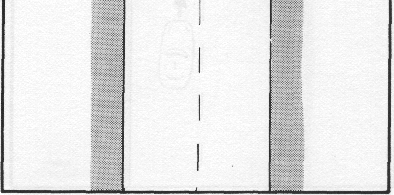
VEHICLE ATTACK
If you should be fortunate enough to get behind your attacker's vehicle, you can easily
knock him off the road.
The most effective means of doing this is illustrated in Figure 13. Hit the enemy vehicle's
bumper at the angle illustrated. You should be going 10 to 20 mph faster than he is. Remember
to hit, not push, the vehicle.
After impact, the enemy's vehicle will go sliding sideways down the road until his tires
regain traction. When this happens, his car will go in the direction it is pointing -- off the road.
Figure 14 illustrates another method to knock someone off the road. In this situation,
you would pull alongside the rear of the enemy vehicle and crash into his rear wheel section.
This will cause him to spin out and go off the road. Immediately after impact, hit the brakes
and counter steer to break contact.
Running Someone off the Road
Figure 15 illustrates a method used to run someone off the road. Note how the center of
the white vehicle is pressing against the front of the black vehicle. By doing this, the white
vehicle is using its total body weight against only a small portion of the black vehicle. Through
this method, a small car can force a much larger one off the road.
Assassinations
A very common method of assassination is for an attacking vehicle to pull alongside the
victim's car and simply blast away at everyone inside. This method is very popular in Central
America.
The best defense against this type of attack is to slam on the brakes, causing the
attacker to overshoot your vehicle. A bootlegger's turn could also be employed (if the shoulder
of the road is wide enough), or you could make a quick turn off the road. If you are faced with
an attack from a motorcycle, you can simply smash into him, thereby ending the threat.
Figure 13
Knocking a Vehicle off the Road
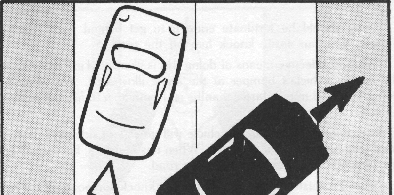
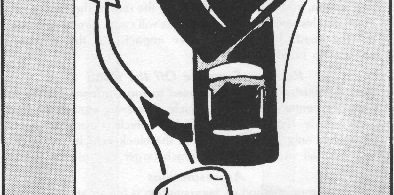
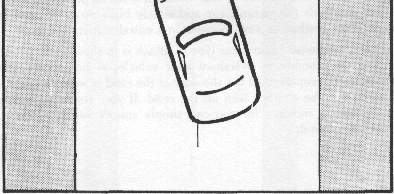
Figure 14
Another Method of Knocking a Vehicle off the Road
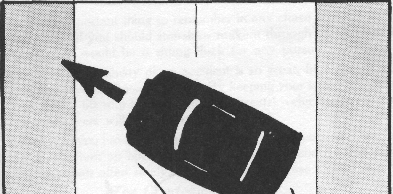
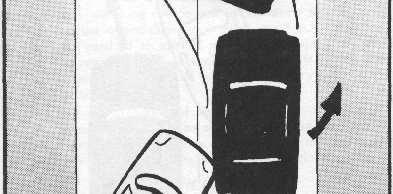

Figure 15
Running someone off the road

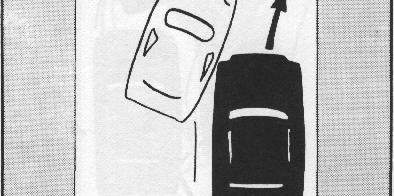

CHASE SITUATIONS
The most important thing to remember in any chase situation is not to crash. Even if
you should somehow make it through an accident in one piece, you would be a sitting duck for
any pursuer.
Because the probability of an accident is so great, high speeds are not recommended in
chase situations. By keeping your speed relatively low, say under 65 mph, you will have greater
vehicle control and evasive maneuvers will be easier to accomplish.
Of course, if you have a superior car to that of your pursuer, you can just flat outrun
him on open roads. On certain stretches of interstate highway, you can often safely run at
speeds in excess of 100 mph.
The Overtaking Vehicle
Never let any attacking vehicle pull up alongside you. If he does manage to position
himself there, he is either going to shoot, or try to run you off the road. If an attempt is made
to overtake you, it will probably be on your left side. To make this more difficult, drive as far to
the left as you possibly can. Should he try to overtake you anyway, try to swerve in front of
him.
Special Devices
Special devices such as smoke screens, oil slicks, and spotlights should be employed just
before turns. If your pursuer is blinded or goes into a skid just before a turn, he will very likely
crash.
Going Off the Road
It may be necessary to go off the road to lose a pursuer. Be sure not to get stuck in a
ditch or drive into a dead end, however. It is surprising how far off the road an ordinary car will
actually go, if you drive it carefully.
Jumping Curbs
Jumping a curb is a good way to avoid a blockade in the street. A curb can be easily
jumped as long as you remember to hit it at an angle of approximately 45 degrees and at a
speed under 45 mph.
Shooting
Any passengers riding shotgun should be seated in the back. This allows them to shoot
in any direction without interfering with the driver.
Targets of choice on the enemy vehicle are the driver and the front tires. Obviously, if
the driver is incapacitated the chase will not continue. If either front tire goes flat, the attacker
won't be able to steer. For best results, try to score a direct hit into the sidewall.
Since the first edition of this book, I have spent some time shooting at junk cars with
firearms of various calibers. The results of my tests are as follows:
(1)No pistol round can be counted on to penetrate the vehicle body or glass or to
flatten a tire.
(2) Pistol rounds will crack the glass and deflect away. While the rounds I
used (.45 and 9mm) did penetrate the tires, it took about 20 minutes for them to go
completely flat.
(3) Rifle rounds of .223 and .308 caliber will definitely penetrate any unarmored vehicle.
The .308 flattened tires much faster than the .223.
Shotgun loads with the exception of slugs are useless for stopping any vehicle. They
won't penetrate the glass, body, or the tires. Slugs, however, will blast huge holes
through the vehicle and will almost instantly flatten a tire.
If You Can't Get Away
If you absolutely cannot get away from your pursuers, drive your car into a wooded
area. When your car won't go any further, get out and get behind cover. If your pursuers are
still intent on coming after you, they are going to have to exit their vehicle. When they do, you
can ambush them.
Never give up when attacked. Violent criminals and terrorists almost always kill their
victims. Even those few people who are held hostage and then released usually require some
kind of psychological care after their ordeal. Some have even become permanent basket cases.
A Useful Maneuver
Figure 16 shows a maneuver which will lose almost any pursuer. By cutting just in front
of traffic coming in opposing lanes, you make it almost impossible for anyone to follow.
Figure 16
A Useful Evasive Maneuver
By cutting in front of oncoming traffic, the intended victim (white car) makes it all but impossible for the
attacker (black car) to follow.
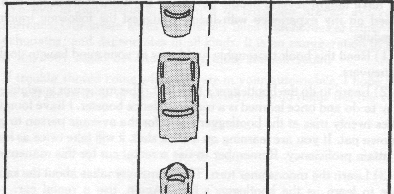
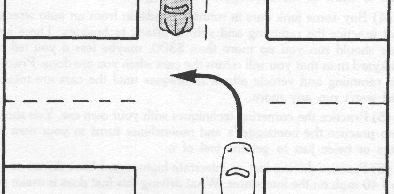
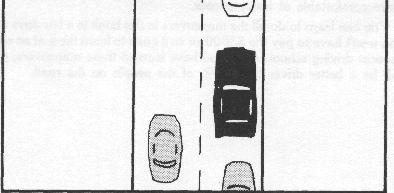
SUGGESTED TRAINING SCHEDULEI have taught several people how to do the maneuvers in this book. Based on my
experience with them, I suggest the following training schedule:
(1) Read this book thoroughly and know in your mind how to do the maneuvers.
(2) Learn to do the bootlegger's turn first. This maneuver is relatively easy to do and
once learned is a real confidence booster.
(3) I have found it takes twenty tries at the
bootlegger's turn for the average person to get it down pat.
(4) If you are learning on a
stick shift, it will take twice as long to attain proficiency. Remember to use a rental
car for this maneuver.
(5) Learn the moonshiner’s turn. This maneuver takes about the same time to learn as
the bootlegger's turn. Again, use a rental car.
(6) Buy some junk cars in running condition from an auto wrecker and practice the
ramming and vehicle attack techniques. Three junk cars should run you no more
than $300, maybe less if you tell the junkyard man that you will return the cars
when you are done. Practice the ramming and vehicle attack techniques until the
cars are totalled and won't run any more.
Practice the cornering techniques with your own car. You should also practice the
bootlegger's and moonshiner’s turns in your own car once or twice just to get the
feel of it.
Practice driving fast on interstate highways. I have driven as fast as 140 mph on the
interstates. What driving this fast does is make you more comfortable at lesser
speeds.
You can learn to do all the maneuvers in this book in a few days and you won't have to
pay the $3000 or so it costs to learn them at an anti-terrorist driving school. After you have
learned these maneuvers, you will be a better driver than 95% of the people on the road.
CONCLUSION
We live in dangerous times. Acts of terrorism are an everyday occurrence. Our urban
areas are literally filled with hordes of criminals, psychopaths, and degenerates of all kinds. It is
no exaggeration to say that anybody could be attacked by these human scums.
If trouble should come while you are in your automobile, I hope this book will prove to
be of value. I wish everyone who reads this the very best.
USEFUL REFERENCES
The following publications are recommended for further study.
EMERGENCY AND HIGH SPEED DRIVING TECHNIQUES by John M. Clark, Jr.,
Gulf Publishing Co., Houston, TX, 1976.
I found this book almost impossible to read. The author goes way overboard on theory
and mathematical calculations. Nevertheless, it does contain some valuable information.
FUNDAMENTALS OF PHYSICAL SURVEILLANCE by Raymond P. Siljander.
Charles C. Thomas Publishers, Springfield, IL, 1977.
This book is known as “the bible of surveillance”. It has an excellent section on
automobile surveillance.
THE CRIMSON WEB OF TERROR by Robert D Chapman,
Paladin Press, Boulder, CO, 1980.
This is the best book 1 have read on terrorism. It is also one of the few that is not sympathetic
to terrorists.
VEHICLE MODIFICATIONS FOR URBAN SURVIVAL
C.W.L., Inc., Pasadena, CA. 1981.
A worthwhile book. Among other things, it contains plans for making a pressurized oil
slick and smoke screen.
DRIVING IN COMPETITION by Alan Johnson,
WAV. Norton & Company, New York. 1971.
COMPETITION DRIVING by Gerry Marshall,
W. Foulsham & Co., Ltd., New York, 1979.
These are by far the best books written on racing. The first book is particularly strong
on the fundamentals. The latter is for more advanced drivers.
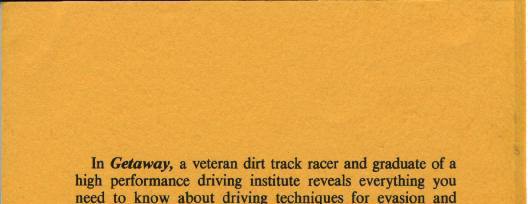
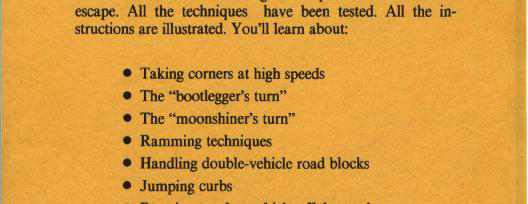
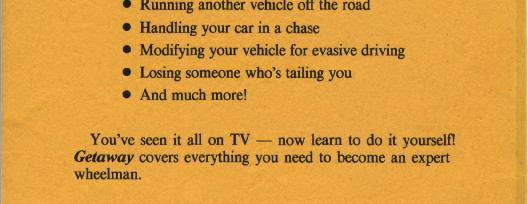
a bit too much for my 2 minutes will check back :)